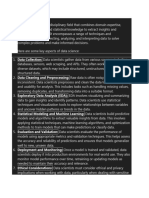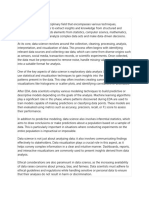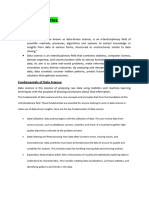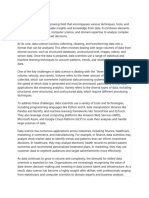0% found this document useful (0 votes)
26 views2 pagesFacets of Data Science
Data science involves data collection, cleaning, analysis, and visualization, focusing on structured, semi-structured, and unstructured data. It employs various analytical techniques including descriptive, diagnostic, predictive, and prescriptive analytics, alongside machine learning methods. The data science lifecycle encompasses problem definition, data preparation, exploration, model building, and deployment.
Uploaded by
Gulbir SinghCopyright
© © All Rights Reserved
We take content rights seriously. If you suspect this is your content, claim it here.
Available Formats
Download as DOCX, PDF, TXT or read online on Scribd
0% found this document useful (0 votes)
26 views2 pagesFacets of Data Science
Data science involves data collection, cleaning, analysis, and visualization, focusing on structured, semi-structured, and unstructured data. It employs various analytical techniques including descriptive, diagnostic, predictive, and prescriptive analytics, alongside machine learning methods. The data science lifecycle encompasses problem definition, data preparation, exploration, model building, and deployment.
Uploaded by
Gulbir SinghCopyright
© © All Rights Reserved
We take content rights seriously. If you suspect this is your content, claim it here.
Available Formats
Download as DOCX, PDF, TXT or read online on Scribd
/ 2






















































































